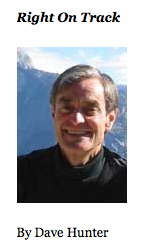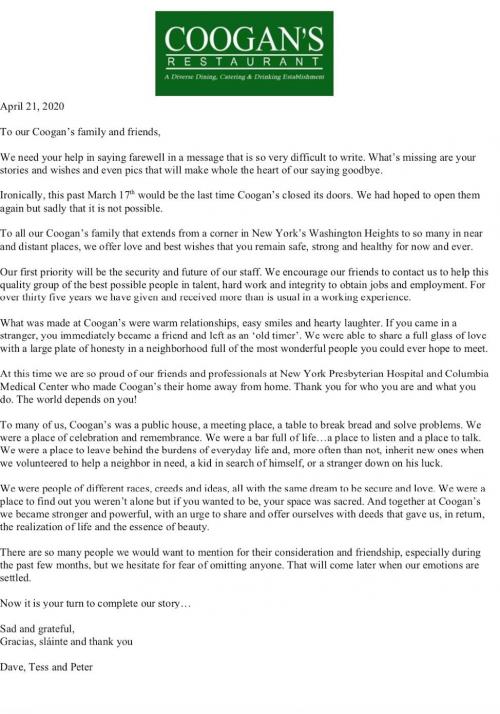Updated April 21, 2020
We recieved the following letter via Jeff Benjamin on 20 April 2020. It speaks of Coogans, a NY institution, closed on 17 March 2020. The NY Times posted a piece on the closing, noting that it was part of New York City that would not survive the modern plague. The New York Times titled it, “Coogans is Closing. This is the New York we are loosing.” Please read it.
RelatedPosts
The following piece is by David Hunter, long time scribe for RunBlogRun. David penned this piece on December 16, 2013. It speaks of Peter Walsh, one of the triumviratre behind Coogans….please read it and know that Coogans was one of those positivesanctuaries of our sport.
Peter Walsh is one of the most energetic and positive people one would hope to meet. Walt Murphy and Larry Rawson, two of my mentors in this sport, introduced me to Peter at Coogans just a few years ago. What a place and what a wonderful person. Here is David Hunter’s masterful piece on Peter and the magic that is Coogans.
The Toastmaster Of Track & Field
Exuberant Peter Walsh Lifts The Sport
December 15, 2013
Those who love track & field of course appreciate the purity of the sport itself: the raw, unbridled competition revealing who can run the fastest, jump the highest, and throw the farthest. But there is also an important social component that can add to this experience. After a cleansing long run, an uplifting workout, or an exciting track meet, there is nothing that quite compares to retiring with friends to an inviting meeting place for a bite to eat, a tankard of ale, and some spirited conversation.
Runners of all types can cite many such celebratory venues in all corners of the globe. But perhaps the most recognized, the most revered such gathering spot is Washington Heights’  Coogan’s Irish Pub & Restaurant – a quaint and cozy watering hole located in Manhattan’s upper west side at West 169th Street and Broadway. “We built Coogan’s here just about 30 years ago,” explains co-owner Peter Walsh. “It was four individual stores previously – a Chinese restaurant, a luncheonette, a dry goods store, a card shop. The building started in 1983 and was completed in 1985.”
Coogan’s Irish Pub & Restaurant – a quaint and cozy watering hole located in Manhattan’s upper west side at West 169th Street and Broadway. “We built Coogan’s here just about 30 years ago,” explains co-owner Peter Walsh. “It was four individual stores previously – a Chinese restaurant, a luncheonette, a dry goods store, a card shop. The building started in 1983 and was completed in 1985.”
Walsh – a larger-than-life personality with an infectious zest – is a curious blend of successful business man, outside-the-box free thinker, and mischievous rogue elephant who does it his way. Walsh grew up in New York’s east side Yorkville area – “I remember speaking German in the streets.” – and launched off as a young business man operating – and soon owning – a small, but popular restaurant/bar on the upper East Side. When he sold the building and the business around 1980, Walsh made a Solomonesque decision about how to utilize the sale proceeds. “I decided that I was going to have my retirement when I was young,” Walsh offers with a wide grin. “I used half the money to go to Europe and live in Paris. And I invested the other half,” he explains. “It was a ball. I lived in Paris playing the Blues.”
When his youthful “retirement fling” concluded in 1983, Peter Walsh returned to New York and immediately focused on the Washington Heights area and his plan to develop – along with his two partners Dave Hunt and Tess McDade – a premiere neighborhood restaurant and pub. He faced a daunting task. In the early ’80’s, the Washington Heights community – nestled close to the George Washington Bridge – was a virtual gateway for New York drug trafficking and an epicenter for drug-related crimes. “When we began Coogan’s, the entire neighborhood was just going downhill, downhill, and downhill,” laments Walsh. “The Armory – with decades of track & field history – had become a homeless shelter. It had gotten to the point that kids would be running track in the Armory and there would be homeless people sleeping in the infield. It was crazy, it was insane. At one time there were over 2000 homeless people living in the Armory.”
Walsh – along with Armory savior Norb Sander and other Washington Heights community leaders – fought back. Walsh’s plans for Coogan’s went forward. Less than a decade later, the rejuvenated Armory – like a phoenix rising from the ashes – reclaimed its former position as the most visible symbol of a proud neighborhood. The collaborative investment of time, energy, and capital paid off as – block by block – the greater community transformed the mean streets of Washington Heights into what is now a revitalized upper west side neighborhood.
Today, Coogan’s is both an establishment with a national reputation and a neighborhood haunt. Coogan’s track & field theme gives the restaurant a relaxed, comfortable, old-school feel. Memorabilia – a respectful nod to the wonderful heritage of our sport – is everywhere. Several hundred racing singlets – from every college and track club imaginable – hang from the elevated ceiling. Lovingly tucked into a prominent corner is the Al Oerter table – complete with a framed and autographed discus and black and white action photo of the 4-time Olympic gold medalist who often frequented Coogan’s. Signed photos of track & field royalty – past and present – line the walls. And the private dining room provides a rare treat: framed covers of every Sports Illustrated that has ever featured a track & field athlete. But there is a local neighborhood ambiance to Coogan’s as well. Homage is paid to Washington Heights as framed photos of local politicians, police, and firefighters are interspersed with accomplished Irish milers and notable New York long jumpers. There is even a wonderful old poster heralding an upcoming concert of Frankie Lymon and The Teenagers in reverence to Washington Heights’ claim as the birthplace of spontaneous lamppost doo-wop.
Looking back, Peter Walsh unhesitatingly acknowledges that transforming disparate real estate parcels into a now-famous destination eatery and bar was a labor-intensive feat. But the determined and resourceful businessman always knew he could get it done. What the entrepreneur didn’t know was that – along the way – he would fall in love with track & field.
With his business located in same block as the Armory, Walsh and Coogan’s couldn’t help but cross paths with all aspects of track & field: the current athletes, the former athletes, the officials, the fans, etc. But what drew Walsh close to the sport? “It’s the personalities,” Walsh confides. “The people who are involved, to me, are some of the most wonderful people in the world. Other sports should have the attitude of track. We’re more cerebral. Track gives you more time to think.”
Peter Walsh also has definite – and somewhat novel – ideas about how track & field might best reclaim its former prominence in the crowded world of sports.
On America’s inherent competitive advantage: “We have all the ingredients that the rest of the world doesn’t have. We have high school and collegiate programs here like no other place in the world. We can make track & field economically solvent by making the sport interesting to companies that are not necessarily track-involved companies. We basically have to sell the sport to the people with the money.”
On inspiring the next generation of athletes: “If you are going to be a good runner here, literature is where the inspiration will come from. If you read about what has gone before, there is no greater inspiration. To know the history of this sport gives you the drive to be successful tomorrow. There is no story about track & field that I have ever read that could not be a movie. The stories are invariably about an athlete’s body, their desire, and sacrificing everything in their life to be great.”
On rekindling the sport’s connection with the American public: “We should think about taking the ‘usual’ of track & field and showcasing it in ‘unusual’ places. Why not have a sprint at halftime of a football game – goal post to post? Why not have a high jump on top of the Empire State Building? Why not have a pole vault competition in the ice skating rink at Rockefeller Center? To bring the sport to the unusual is bringing the sport to the people. I think it has to be done that way to show the explosion, the strength of the sport to many who don’t appreciate what track & field is.”
Walsh is animated as he explains why track & field and its successful athletes are a breed apart. “There are few sports like track & field where the athlete has to take himself or herself to the point where if they go the next step they are broken. It is a type of peaking. And if they don’t go to that threshold, they lose,” offers Walsh as he cites the brinksmanship required not only by track & field athletes who excel but also by those who coach them. “To me, that is the essence of what great coaching is: the ability to recognize the difference between cultivating an athlete’s pinnacle performance and breaking a runner,” explains Walsh intently. “You don’t have that in basketball or football or baseball – those are rhythm sports.” A round of Coogan’s Ale arrives at the table as Walsh continues to decipher the dedication, the willingness to take risks, and the complex personalities so evident in the sport’s marquee performers. Suddenly his countenance lightens, a smile emerges, and the Toastmaster of Track & Field sums it up this way: “You show me a free spirit and I’ll show you a runner.”
~Dave Hunter
Author

Dave Hunter is an award-winning journalist who is a U.S. Correspondent for Track & Field News. He also writes a weekly column and serves as Senior Writer for www.RunBlogRun.com, and covers championship track & field competition domestically and in such global capitals as Moscow, Birmingham, Zurich, Brussels, Beijing, Rio de Janeiro, Zagreb, Ostrava, and Doha. Hunter frequently serves as the arena or stadium announcer for championship track & field gatherings, including the Ivy League, the Big East, the Mid-American Conference, the NAIA, the Big Ten, and the Millrose Games. Hunter has undertaken foreign and domestic broadcast assignments. He ran his marathon P.R. 2:31:40 on the Boston Marathon course back in the Paleozoic Era. To find out more about Dave, visit his website: www.trackandfieldhunter.com He can be reached at: dave@trackandfieldhunter.com
View all posts






















